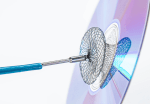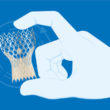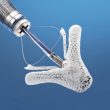The edge-to-edge approach with MitraClip has been established as a valid strategy for patients who experience severe symptomatic mitral regurgitation (MI) with high risk for surgery, currently with a IIa indication. MI complicated by cardiogenic shock, which results in a high risk for conventional valve surgery, is a particularly complex scenario. In such a case,...
MYVAL, a TAVR Balloon-Expandable Valve with Promising Results
TAVR has been shown beneficial over time, and with the development of new generation of prosthetic valves and implantation techniques, outcomes have been improved, reducing the incidence of leaks y and the need for definite pacemaker. This study looked at the evolution of 100 patients with symptomatic aortic stenosis treated with Myval THV from Meril...
EVOQUE: Transcatheter Tricuspid Valve Replacement, One-Year Outcomes
Treating tricuspid regurgitation (TR) has gained increasing importance in interventionism. There is abundant literature on the negative natural evolution of this condition and its unfavorable prognosis, as well as the clinical challenges associated to optimal medical treatment. Among its percutaneous treatment options, both edge-to-edge repair devices (TEER), as showed in TriValve and TRILUMINATE trials, and...
Untreated Aortic Stenosis: Associated Mortality and a Call to Attention
The progression of aortic stenosis has been extensively studied and is well-known. As observed, in its advanced stages, this condition entails high morbidity and a marked decrease in survival. Both North American and European guidelines recommend treatment when faced with severe valve disease. However, true severity can be difficult to determine due to discordant data,...
Left Atrial Appendage Occlusion: Clinical Outcomes according to Device Implantation Depth
Continuous improvement of left atrial appendage occlusion (LAAO) devices has had a positive impact on the safety and efficacy of this technique. However, device related thrombus formation (DRT) is still a major concern because of the associated increased risk of thromboembolic events. Approaching this complication calls for more intense antithrombotic treatments, which in turn involves...
TAVR Durability at 5 Years in Intermediate Risk Patients
TAVR has been shown beneficial in patients across the risk spectrum. The PARTNER 2 SAPIEN 3 (P2S3i) study on intermediate risk patients was the first to show TAVR superiority vs SAVR when using the transfemoral approach. SAVR durability has been shown in different analysis but, except for a few reports, TAVR durability at long term...
Is Edge-to-Edge Treatment with PASCAL Effective at 3 Years?
Mitral regurgitation is the most common valvular heart disease. Its cause is most frequently functional or secondary dysfunction (functional mitral regurgitation, FMR) compared with degenerative mitral regurgitation (DMR), which is associated with decreased ventricular function, hospitalization for heart failure, and mortality. While medical treatment is effective over extended periods, a significant number of patients cannot...
COAPT: Nutritional Condition Is an Important Factor in Edge-to-Edge Treatment
Heart failure is strongly associated with malnutrition or poor nutrition, which has been linked to increased mortality during follow-up. We know that mitral regurgitation causes progressive heart failure and affects nutrition. The COAPT Study has demonstrated the benefits of edge-to-edge treatment in mitral regurgitation when combined with comprehensive medical treatment and maximum tolerated doses. However,...
COAPT: Promising 5-Year Outcomes
Secondary ischemic and non-ischemic mitral valve failure (SMR), produce left ventricle dilation, papillary muscle displacement, and impaired leaflet closure causing regurgitation. This will lead to ventricular function deterioration and bad prognosis. Edge-to-edge mitral valve repair with MitraClip has been shown safe and effective to treat SMR in the short term, but its evolution at 5...
ACC 2023 | TAVR in Low Risk Patients: 3-Year Outcomes
At present, transcatheter aortic valve replacement (TAVR) has become the gold standard in the US, regardless surgical risk. The current ACC and AHA guidelines recommend that a Heart Team make the decision for 65 to 80-year-old patients with aortic stenosis. In low risk patients, fast recovery and short term benefits of TAVR should be weighed...









